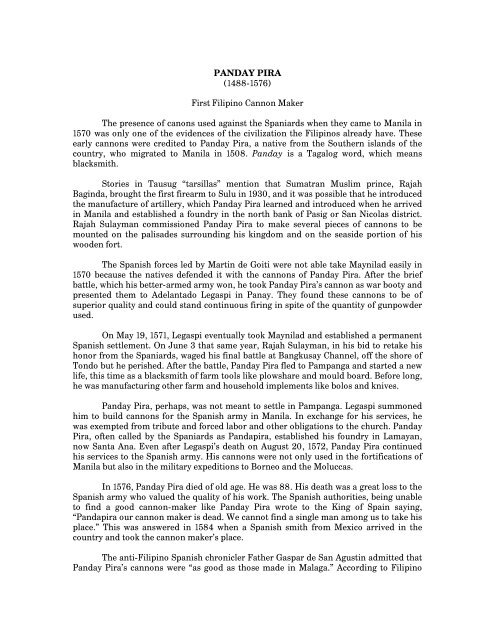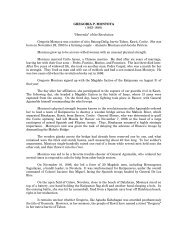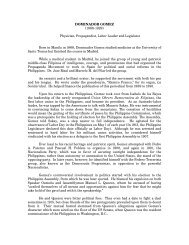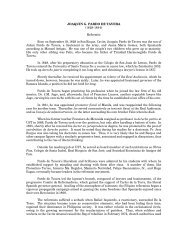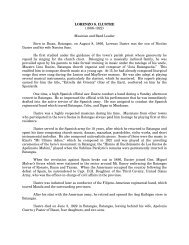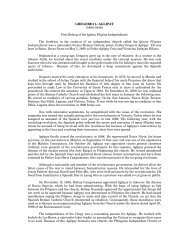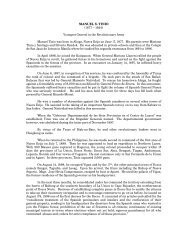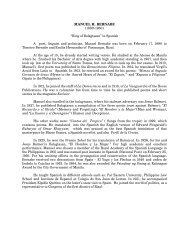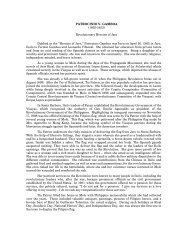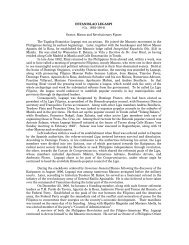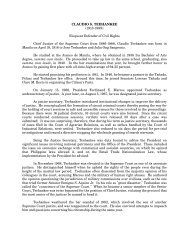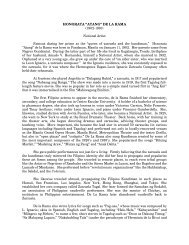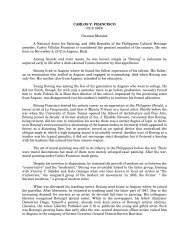PANDAY PIRA (1488-1576) First Filipino Cannon Maker The ...
PANDAY PIRA (1488-1576) First Filipino Cannon Maker The ...
PANDAY PIRA (1488-1576) First Filipino Cannon Maker The ...
You also want an ePaper? Increase the reach of your titles
YUMPU automatically turns print PDFs into web optimized ePapers that Google loves.
<strong>PANDAY</strong> <strong>PIRA</strong><br />
(<strong>1488</strong>-<strong>1576</strong>)<br />
<strong>First</strong> <strong>Filipino</strong> <strong>Cannon</strong> <strong>Maker</strong><br />
<strong>The</strong> presence of canons used against the Spaniards when they came to Manila in<br />
1570 was only one of the evidences of the civilization the <strong>Filipino</strong>s already have. <strong>The</strong>se<br />
early cannons were credited to Panday Pira, a native from the Southern islands of the<br />
country, who migrated to Manila in 1508. Panday is a Tagalog word, which means<br />
blacksmith.<br />
Stories in Tausug “tarsillas” mention that Sumatran Muslim prince, Rajah<br />
Baginda, brought the first firearm to Sulu in 1930, and it was possible that he introduced<br />
the manufacture of artillery, which Panday Pira learned and introduced when he arrived<br />
in Manila and established a foundry in the north bank of Pasig or San Nicolas district.<br />
Rajah Sulayman commissioned Panday Pira to make several pieces of cannons to be<br />
mounted on the palisades surrounding his kingdom and on the seaside portion of his<br />
wooden fort.<br />
<strong>The</strong> Spanish forces led by Martin de Goiti were not able take Maynilad easily in<br />
1570 because the natives defended it with the cannons of Panday Pira. After the brief<br />
battle, which his better-armed army won, he took Panday Pira’s cannon as war booty and<br />
presented them to Adelantado Legaspi in Panay. <strong>The</strong>y found these cannons to be of<br />
superior quality and could stand continuous firing in spite of the quantity of gunpowder<br />
used.<br />
On May 19, 1571, Legaspi eventually took Maynilad and established a permanent<br />
Spanish settlement. On June 3 that same year, Rajah Sulayman, in his bid to retake his<br />
honor from the Spaniards, waged his final battle at Bangkusay Channel, off the shore of<br />
Tondo but he perished. After the battle, Panday Pira fled to Pampanga and started a new<br />
life, this time as a blacksmith of farm tools like plowshare and mould board. Before long,<br />
he was manufacturing other farm and household implements like bolos and knives.<br />
Panday Pira, perhaps, was not meant to settle in Pampanga. Legaspi summoned<br />
him to build cannons for the Spanish army in Manila. In exchange for his services, he<br />
was exempted from tribute and forced labor and other obligations to the church. Panday<br />
Pira, often called by the Spaniards as Pandapira, established his foundry in Lamayan,<br />
now Santa Ana. Even after Legaspi’s death on August 20, 1572, Panday Pira continued<br />
his services to the Spanish army. His cannons were not only used in the fortifications of<br />
Manila but also in the military expeditions to Borneo and the Moluccas.<br />
In <strong>1576</strong>, Panday Pira died of old age. He was 88. His death was a great loss to the<br />
Spanish army who valued the quality of his work. <strong>The</strong> Spanish authorities, being unable<br />
to find a good cannon-maker like Panday Pira wrote to the King of Spain saying,<br />
“Pandapira our cannon maker is dead. We cannot find a single man among us to take his<br />
place.” This was answered in 1584 when a Spanish smith from Mexico arrived in the<br />
country and took the cannon maker’s place.<br />
<strong>The</strong> anti-<strong>Filipino</strong> Spanish chronicler Father Gaspar de San Agustin admitted that<br />
Panday Pira’s cannons were “as good as those made in Malaga.” According to <strong>Filipino</strong>
historian Jaime de Veyra, “Panday Pira’s cannons are as good as those produced in Spain<br />
and became the official cannon-maker for the Spanish army in the Philippines. His<br />
efforts contributed much to the defense of the islands against sea pirates.”<br />
References:<br />
Quirino, Carlos. Who’s who in Philippine History. Manila: Tahanan Books, 1995.<br />
Zaide, Gregorio F. Great <strong>Filipino</strong>s in History. Manila: Verde Bookstore, 1970.


